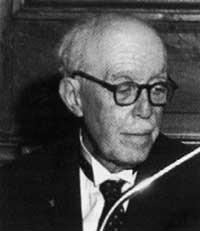Louis Victor de Broglie
Elhuyar Fundazioa
De Broglie was born into the family of aristocrats in Dieppe, Normandy, on August 15, 1892. His family was famous since the time of King Louis XIV for the services rendered in the French Court. Berraitone was killed with guilotine during the French Revolution.
De Broglie studied at the Sorbonne in Paris and, after obtaining a degree in History, decided to undertake his scientific career. He participated as a radio expert in the First World War and later in 1924 received the title of doctor in the Sorbonne for his thesis entitled “Studies on quantum theory”.

A year earlier, in 1923, however, he showed that each particle must carry a wave. He used Einstein's formula that relates mass to energy and Planck's formula that relates frequency to energy. The length of these waves is inversely proportional to the moment of the particle. For particles of electron size, the wavelength is similar to that of x-rays and can be detected. This is what Davisson and Thomson did in 1927.
The blow-wave duplicity of the electron corresponded to the blow-wave duplicity of the photon, as Compton demonstrated. According to Einstein, matter is only a form of energy and matter can become energy (or vice versa). In the face of this, the particles could have waveform or the waves could adopt particle form.
Schrödinger used the new concept of electronic wave to complete the diagram of the structure of the atom. In this scheme, moving electronic particles generated stationary waves. In turn, Lewis' static electrons, by creating the chemical bond, generate Pauling's electronic resonant waves.
De Broglier received the Nobel Prize in 1929 for his work in physics. In 1932 he was lecturer at the Henri Poincaré Institute for his teaching as a theoretical physicist.
A member of the French Academy of Sciences since 1933, he was appointed secretary for his life in 1942. In 1944 he was a member of the French Academy and since 1945 he was a member of the French Atomic Energy Commission. By then he had already published the works “New physics and how many” (1937) and “Continuity and discontinuity in modern physics” (1941). In addition, he left numerous works, among them the so-called “Physics and Microphysics” (1947) and “Sages and Discoveries” (1951). In 1952, the United Nations awarded him the Kalinga Prize for his works on science and for the general public.
Around 1955 he began working on the elimination of probabilistic character through quantum theory with a “double solution”. I wanted to associate quantum mechanics with classical wave structure, but today De Broglie's route has no continuity.
He recently died in Paris (1987).





